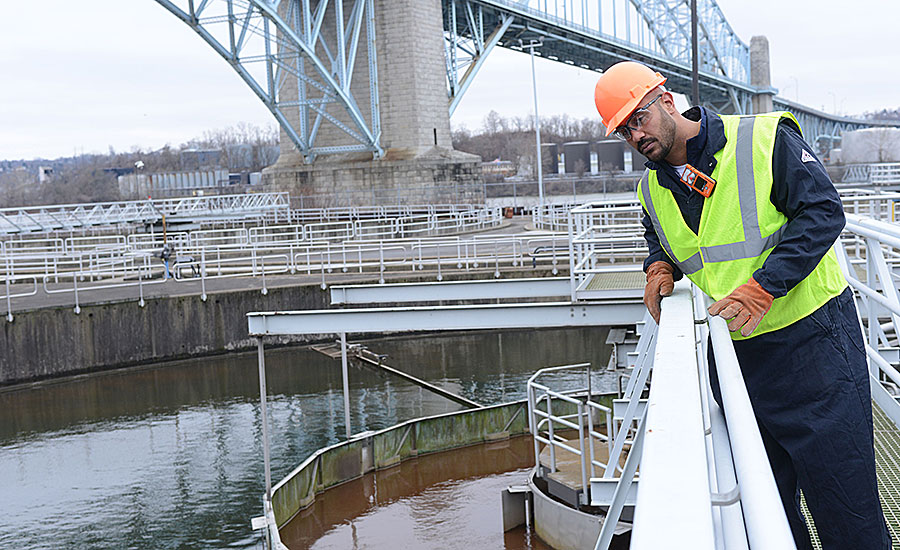Learn how to better detect hazardous gases and improve efficiency in wastewater plants

For people who work at water and wastewater treatment facilities, gases are very potent hazards that could threaten safety at any moment.
Wastewater plants are full of confined spaces, like recirculation pits, clarifier tanks, and wet wells. These spaces alone can be hazardous, and the danger only increases when you consider the gases that can permeate the air at wastewater treatment facilities.
Methane and hydrogen sulfide, byproducts of decomposing organic materials in waste flows, can displace oxygen or even cause explosions. Additionally, the purifying chemicals used to decontaminate effluent water can be hazardous to workers. Chlorine, ammonia, and chlorine dioxide are common at wastewater treatment plants, and they all pose health risks if inhaled in sufficient concentrations.
Since it's impossible to eliminate these gas hazards from the wastewater treatment process, workers must have access to reliable gas detection equipment, including personal gas detectors.
Why fixed gas detectors aren’t sufficient
Many wastewater plants rely on fixed gas detectors and confined space monitoring kits to identify hazardous gases. While these solutions can be effective in their intended applications, they can only alert workers to gas hazards in those specific areas.
Similarly, employees responsible for entering confined spaces likely know the procedures for entering that confined space safely. They know to take their pre-entry samples and they understand the critical nature of the 2-by-2 rule. But gas hazards can and do escape the confined space into the rest of the facility. If you rely on fixed gas detectors or confined space monitoring kits, your people could be unknowingly exposed to hazards.
This is why your gas detection program should include personal, wearable gas detectors to alert your people to gas hazards no matter where they work. By equipping workers with the right personal detectors, your team will be able to monitor gas hazards in real time, no matter where they’re located.
In short, gases and people are mobile, so you need gas detectors that are mobile, too.
The benefits of personal gas detectors
Wastewater facilities that are serious about employee safety are much more likely to use personal gas detectors. These detectors offer three distinct advantages for wastewater plants.
1. Enhanced Safety: Employee safety is, after all, the number one goal of gas detection equipment. Personal gas detectors can help workers stay safe by alerting them when they need to evacuate an area, thus reducing accidents and injuries.
However, when a gas detector's alarm sounds, employees can panic if they haven’t been properly trained. This is why newer personal detectors provide alarm action messages with instructions like "Evacuate" or "Wear Respirator" to reinforce a worker's hazard training. Everyone responds to emergencies differently, so it can be helpful to have a reminder of the appropriate action.
Another enhanced safety feature of personal gas detectors is the ability to share gas data and alert peers when someone is in danger. Even when properly trained and equipped, workers can be overcome or incapacitated by a gas hazard. When this happens, the ability to call for help is a literal life saver. Some personal gas detectors include panic buttons and can automatically alert peers in the area when a worker experiences a high gas concentration or stops moving. Newer personal gas detectors can take these benefits a step further by relaying gas readings and other emergency alerts to live monitoring software via cellular, wi-fi, or a connectivity gateway. Safety personnel can then get text alerts when a worker needs help, leading to faster response times and greater visibility into the hazards affecting workers around your facility.
All of these features are designed to ensure that workers can evacuate to a safe location before it’s too late. In a life-or-death situation, personal gas detectors can make all the difference.
2. Improved Efficiency: Personal gas monitors automatically collect valuable data about safety across your facility. These data and event logging capabilities make life much easier for facility managers by aggregating data that would otherwise take valuable man hours to collect. Studies show that automatic data reporting collects up to five times as much alarm information as manual data reporting, so using personal gas monitors with automatic data logging gives facility managers a more accurate operating picture with less time investment.
3. Low Maintenance: Device maintenance is always a concern, especially with portable technologies. A mobile device loses its appeal quickly if it is too complex or time-consuming to maintain. Luckily, most personal gas detectors have options to make maintenance easy.
Docking stations are a popular option to automate charging, bump testing, and calibrating based on a customizable schedule. Docking stations can also create compliance records and track gas detection data to more accurately assess your facility's safety.
Subscription-based services for gas detector repair and replacement are another great option because they simplify all aspects of your gas detection program—gas detector maintenance, repair, cost, and availability—by delivering equipment on demand. Service programs use data from docking stations to identify when monitors need maintenance, then dispatch a new device to you before your monitor fails.
Gas safety requires training
Providing workers with the right personal gas detectors is a great start, but your workers also need to be trained thoroughly, either in-person or online. The alarms on personal gas detectors can only do so much. Wastewater plant employees must know how to use their equipment, the industry best practices for gas detection, and what to do when an alarm does sound.
Gas safety should never be taken lightly. Every wastewater treatment plant should take a holistic approach to addressing gas safety, and personal gas monitors are a crucial aspect of this approach.
Looking for a reprint of this article?
From high-res PDFs to custom plaques, order your copy today!






